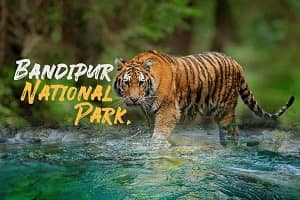Last Updated on 10/08/2023
Once the hunting grounds of the Maharajas of Mysore, Bandipur National Park is today is a wildlife reserve that is home to a fascinating variety of wildlife. The wildlife reserve was originally part of the Venugopal Wildlife Park. In 1973, it became one of the first reserves under Project Tiger, an Indian Government initiative to project the tiger from extinction. It was renamed the Bandipur National Park in 1974.
Protected under the Nilgiri Biosphere Reserve, along with the Nagarahole, Mudumalai and Wayanad Sanctuaries, it is one of the country’s best tiger reserves. The sanctuary is located at the foot of the scenic Nilgiri range.
A mix of dry deciduous, evergreen and scrub forests thrive here as does a multitude of flora and fauna. There are many water bodies, hilltops, abandoned temples and villages to break the monotony of the undulating terrain. The Kabini, Nugu and Moyar rivers flow through the Park. Streams like the Bavali, Moolehola, Kekkanalla and Marandi are other replenishment spots for the animals.

Bandipur is home to large herds of the regal Asian elephant and nearly a hundred majestic tigers. Sighting a tiger is a matter of luck but the more commonly sighted animals include the elephant, Gaur (Indian bison), Chital (spotted deer), Sambar, Dhole (wild dogs), Barking Deer, Langur, Porcupine, Slender Loris, Malabar Squirrels, the Black-napped Hare, the Tiger, Four Horned Antelope, Panther, Sloth Bear, Crocodile, Mouse Deer and Osprey. Reptiles commonly include the Common Rat Snake, Russell’s viper, Common Krait, Indian Python, Flying Snake and Cobra. Many of the species here are endangered ones and protected by law.
Himavad Gopalaswamy Betta
Himavad means “covered in clouds”, a name befitting the lush hill which stands proud at a height of 1455 meters. A temple at the hill top, dedicated to Lord Krishna, is a popular stop for trekkers. Catch a dazzling sunset and a panoramic view of distant surroundings from the hilltop. One can occasionally encounter grazing herds of wild elephants.
Moyar Gorge
The River Moyar winds its way through this area and separates the reserve into the Bandipur and Mudumalai forests in Karnataka and Tamil Nadu respectively. The river cuts the rocky terrain through the 300 meters deep Moyar Gorge. Also famously known as the Mysore Ditch, the gorge is believed to be the only region in Bandipur where the Indian Four Horned Antelope can be sighted.
Safaris
The plethora of wildlife in these forests can be best enjoyed on a safari ride and is therefore a must do on your Bandipur trip. Forest Department vehicles at the Bandipur Tiger Reserve will take you on these safaris. The forest department also arranges for elephant rides. Almost all resorts offer safari activities on request.
The Forest Department conducts van safari and jeep safari.
The Van Safari is a 40 minute drive in a 25 seater van.
The Timings Are:
Morning: 6.30 am to 9 am, Evening: 3.30 pm to 5.30 pm
The Jeep Safari is for a maximum of 5 people at a time and there are two in the morning and two in the evening.
The Timings Are:
Morning: First Trip: 6.30 am to 8 am, Second Trip: 8 am to 9.30 am
Evening: first Trip: 3.30 pm to 5 pm, Second Trip: 5 pm to 6.30 pm
Jungle Lodges & Resorts also conducts safaris in Bandipur for guest staying with them.
The Timings Are:
Morning: 6 am to 8.30 am, Evening: 4 pm to 6.30 pm
Bird Watching
With more than 200 species of avifauna, bird watching in Bandipur can become a preoccupation with bird lovers. Sometimes the chirping of birds is the only sound to break the stillness of early mornings in the forest. Peafowl, the national bird, can be seen in this forest. Besides, birds like Red Spurfowl, Grey Jungle fowl, Herons, Egrets, Partridge, Quail, Lapwing, Warbles and Green Pigeon can be spotted regularly.
Best time to view wildlife – May-June and September – November
Around Bandipur
Nanjangud – 55 km from Bandipur is Nanjangud, a pilgrim centre on the banks of the Kapila River, famous for the massive Nanjundeshwara Temple. Built in Dravidian style, this temple is one of the largest of its kind in Karnataka. The town takes its name from the temple.
How to Reach There:
By Air: Bangalore – 265 km
By Rail: Mysore – 90 km
By Road: Mysore – 90 km, Bangalore – 220 km


 Call
Call WhatsApp
WhatsApp Enquiry
Enquiry